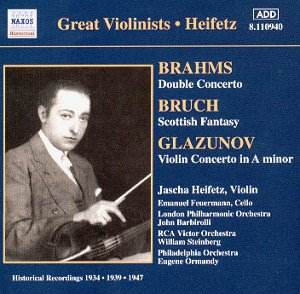Of the Naxos Heifetz Concerto series, available singly
or in a tempting box, this one at least is in the highest sense self-recommending.
Heifetz recorded each work here twice during his career and in the cases
of the Glazunov and Bruch these earlier recordings are much to be preferred.
Whilst there are perhaps more complex issues involved in the Brahms
Double there are still strong grounds for preferring this Feuermann
traversal to the later one with Piatigorsky not least because it is
one of the more strikingly intense string collaborations ever made.
There’s little real need to rehearse the virtues of each performance,
classics of the discography as they are, except to add that the transfers
are excellent and that the disc serves as absolute refutation, if such
should still be necessary after all this time, of Heifetz’s alleged
metallic coldness.
If you have the 1963 RCA Victor/Hendl Glazunov you
will miss an extra level of expressive intensity as well as Barbirolli’s
richly burnished contribution. Heifetz’s nobility of utterance, his
absolute technical eloquence here, his glittering pizzicati and harmonics
are all non-pareil. Some of course swear by Milstein in this work and
his is a superb traversal – there’s room for both, indeed for others.
But for me the extra tonal richness Heifetz brings and the level of
orchestral sophistication involved, the power and apparent spontaneity
are all highly memorable. Try the wind counterpoint and the jaw dropping
Heifetz cadenza in the Tempo primo section (track 3). In the Bruch his
vibrato usage is worthy of an eight page technical treatise. The speed
of it, the variety of it and the colour evoked by it are all bewitching.
The rapt sincerity of his playing in the transition from Andante to
Andante sostenuto is stunning. The finger position changes in which
he indulges are apposite and expressive. His slides and inflexions and
his memorable tone have seldom sounded so utterly beautiful. Let’s forgive
him a few of the cuts he makes. Of contemporary players only Perlman
makes this work live in anything like the same way. The two great string
players turn in a combustible performance in the Brahms. The element
of theatre is sometimes perilously near – neither musician was known
for his humility, personal or musical – and there are moments when there
are things missed, deeper things not fully explored, tonal qualities
sometimes taking precedence over expressive depth. Still, as string
playing it is remarkable.
These are three commanding performances and classics
of the literature in a well transferred disc all revealing much of Heifetz’s
matchless eloquence.
Jonathan Woolf
